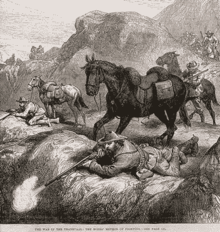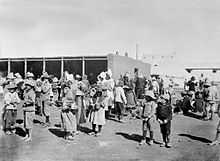Boer Wars

The Boer Wars (Afrikaans: Vryheidsoorloë, literally "freedom wars") were two wars fought during 1880–1881 and 1899–1902 by the British Empire against the settlers of two independent Boer republics, the Orange Free State and the Transvaal Republic.
First Anglo-Boer War

The First Anglo-Boer War (1880–1881), was a fight to keep sovereignty by the South African Republic against British invasion.
- The war was between the South African Republic (ZAR) and the British.
- When the British annexed Transvaal in 1877 the Boers were angered.
- In 1877, the Pedi attacked the Boers of Transvaal, and Boers claimed the British had not adequately assisted them.
- The British wished to bring Transvaal by force into a union, which furthered chances of war.
The South African Republic was victorious.
Second Anglo-Boer War
The Second War (1899–1902), by contrast, was a lengthy war—involving large numbers of troops from the Empire, which ended with the conversion of the Boer republics into British colonies (with a promise of limited self-governance). These colonies later formed part of the Union of South Africa. The British fought directly against the Transvaal and the Orange Free State, defeating their forces first in open warfare and then in a long and bitter guerrilla campaign. British losses were high due to both disease and combat. The policies of "scorched earth" and civilian internment in concentration camps were the cause of suffering in the Boer civilian populations in the Transvaal and the Orange Free State. When news of these strategies reached Britain, there was an erosion of support for the war. Ships like RMS Umbria served Britain during the Second War. Her sister ship, Etruria,didn't go into the war.
Controversy and significance
During the later stages of the Second Boer War, the British pursued the policy of rounding up and isolating the Boer civilian population in concentration camps, one of the earliest uses of this method by modern powers. Women and children were sent to these camps. A report after the war concluded that 27,927 Boer (of whom 22,074 were children under 16) and 14,154 black Africans had died of starvation, disease and exposure in the camps.[1]
A British journalist, WT Stead, wrote:
"Every one of these children who died as a result of the halving of their rations, thereby exerting pressure onto their family still on the battle-field, was purposefully murdered. The system of half rations stands exposed, stark and unashamedly as a cold-blooded deed of state policy employed with the purpose of ensuring the surrender of men whom we were not able to defeat on the field."[2]
The German Empire saw this as a clear sign of British weakness as it was struggling to maintain a portion of its empire in Africa, and sent the Kruger Telegram, congratulating the leader of the Boers on their war effort.[3]
This led to a change in approach to foreign policy from Britain, which now set about looking for more allies. To this end, the 1902 treaty with the Empire of Japan in particular was a sign that the British Empire feared attack on its Far Eastern empire and saw this alliance as an opportunity to strengthen its stance in the Far East. This war led to a change from splendid isolation policy to a policy that involved looking for allies and improving world relations.[citation needed] Later treaties with France ("Entente cordiale") and the Russian Empire, caused partially by the controversy surrounding the Boer War, were major factors in dictating how the battle lines were drawn during World War I.[citation needed]
The Boer War also had other significance. The Army Medical Corps discovered that 40–60% of men presenting for service were physically unfit to fight. This was the first time in which the government was forced to take notice of how unhealthy the British population was. This strengthened the call for the liberal reforms of the first decade of the twentieth century.[4]
The United States Army uses several case studies from the Boer War to teach ethics in combat.
The Boer War greatly affected the English novelist and poet Thomas Hardy, and he was moved to compose the poem "Drummer Hodge".[5]
-

Boer women and children in a British concentration camp.
-

Lizzie van Zyl who died in the Bloemfontein concentration camp.
-

The burning of a Boer farm.
In fiction
The Boer War has been the focus of a considerable body of fiction numbering over two hundred novels and at least fifty short stories in English, Afrikaans, French, German Dutch, Swedish and even Urdu if we count the translation of Rider Haggard's Jess in 1923.
For the social and literary historian it provides over a hundred year record of the relationship between literature and history.
The vast majority of novels and short stories about the Anglo-Boer conflict were published around the time of the war and reflect the values and attitudes to British imperialism. Some of the titles published then give a fairly accurate impression of the patriotic fervour which found its way into print: B. Ronan, The Passing of the Boer (1899); E. Ames, The Tremendous Twins, or How the Boers were Beaten (1900); C.D. Haskim, For the Queen in South Africa (1900); F. Russell, The Boer's Blunder (1900); H. Nisbet, For Right and England (1900) and The Empire Makers (1900). Among the more notable literary figures of the day who were closely associated with the events of the Anglo‑Boer conflict were Rudyard Kipling (1865‑1936); Winston Churchill (1874‑1965); H. Rider Haggard (1856‑1925); Sir Arthur Conan Doyle (1859‑1930); Sir Percy Fitzpatrick (1862‑1931); Edgar Wallace (1875‑1932); and John Buchan (1875‑1940)).
Some of the most interesting names associated with satirising the Anglo‑Boer conflict include H.H. Munro (Saki) (Alice in Pall Mall, 1900); G.K. Chesterton (The Napoleon of Nottinghill, 1904), Hilaire Belloc (Mr Clutterbuck's Election, 1908) and Kipling: "Fables for the Staff", published in The Friend in 1900 in which he lampooned the incompetence of the British general staff. Douglas Blackburn's A Burgher Quixote (1903) is one of the most undervalued works in South African literature.
The end of the Great War saw an interesting ideological shift from imperialism to an ideological commitment to the Union of South Africa. The conflict after the World War 1 is depicted essentially as a civil war in which the members of the same family who have fought on opposite sides must now, for their common good, make peace. This is an attitude already anticipated in Francis Bancroft's (Mrs Francis Carey Slater's) early novels The Veldt Dwellers (1912) and Thane Brandon (1913). It is also the major theme in Daphne Muir's A Virtuous Woman (1929), Norman McKoewn's The Ridge of White Waters (1934), F.A.M. Webster's African Cavalcade (1936), as well as Kathleen Sinclair's saga which includes Walking the Whirlwind (1940), The Sun Rises Slowly (1942) and The Covenant (1944).
From the 1930s there is a diminishing concern with depicting the causes and consequences of the Boer War as dogmatic assertions to be attacked or defended. Coincidentally, there has been a tendency to depict the struggle from the Boer point of view, as in W C Scully's The Harrow (1921), Daphne Muir's A Virtuous Woman (1929) and Manfred Nathan's Sarie Marais (1938).
Seen within the wider context of South African literature the racial theme that had to a large extent lain dormant in Boer War fiction during the imperial phase now begins to assert itself. Only one novelist who wrote about the war during the imperial phase, George Cossins in A Boer of To‑day (1900), admits to a black‑white problem.
Since 1948 the call for unity between Afrikaner and English has remained, but the race issue has become more and more focal. Race relations are a major preoccupation in Henry Gibb's four book saga: The Splendour and the Dust (1955), The Winds of Time (1956), Thunder at Dawn (1957) and The Tumult and the Shouting (1957), and Daphne Rooke's Mittee (1951).
Most writers since 1948, with some notable exceptions, have treated the war largely as the backdrop for historical romance: Stuart Cloete, Rags of Glory (1963); Sam Manion, The Great Hunger (1964); Wilbur Smith, The Sound of Thunder (1966); Dorothy Eden, Siege in the Sun (1967); Josephine Edgar, Time of Dreaming (1968); Daphne Pearson, The Marigold Field (1970); Jenny Seed, The Red Dust Soldiers (1972); Desiree Meyler, The Gods Are Just (1973); and Ronald Pearsall, Tides of War (1978). At the same time there is a greater interest in addressing such vexed questions as the concentration camps, the effects of martial law, the 'Handsuppers' and the results of the scorched earth policy.
The South African conflict was in many respects a civil war. Not only were there many Boers from the Cape, and later the two republics, who joined the National Scouts and fought for the British, but there were many Cape Boers who joined the commandos. This aspect of the war produced some of its finest responses in fiction, for example Herman Charles Bosman's short stories "The Traitor's Wife" and "The Affair at Ysterspruit", and Louis C. Leipoldt's novel Stormwrack (1980). The question of divided loyalties is a large issue in Boer War fiction.
Nor did the conflict end with the war. As late as 1980 a successful Australian film Breaker Morant was based on Kenneth Ross's play and Kit Denton's novel The Breaker (1973).
The Boer War has continued to be a popular subject for escapist fiction. Whereas the writers at the height of the Empire were overwhelmingly British, with the decline of imperialism the field is now dominated by South African writers.
See also
- Breaker Morant, a film set during the Second Boer War
References
- ↑ André Wessels (2010) A Century of Postgraduate Anglo Boer War Studies p.32, Sun Press ISBN 978-1-920383-09-1
- ↑
- ↑ "Kruger telegram (South African history)" Encyclopedia Britannica, accessdate=2013-06-03
- ↑ "How Long Before the Sunset ? British attitudes to war, 1871-1914". History Today. Retrieved 2013-06-03.
- ↑ "Drummer Hodge by Thomas Hardy". Poemhunter.com. Retrieved 2013-06-03.
Further reading
- Beck, Roger B. (2000). The History of South Africa. Westport, CT: Greenwood. ISBN 0-313-30730-X.
- Davenport, T. R. H., and Christopher Saunders (2000). South Africa: A Modern History, 5th ed. Palgrave Macmillan. ISBN 0-312-23376-0.
- Doyle, A. Conan (1902). The Great Boer War. Toronto: George N. Morang & Company.
- Jackson, Tabitha (1999). The Boer War. Basingstoke, U.K.: Channel 4 Books/Macmillan. ISBN 0-7522-1702-X.
- Judd, Denis, and Keith Surridge (2003). The Boer War. Basingstoke, U.K.: Palgrave Macmillan. ASIN B000OLSIXQ. ISBN 0-7195-6169-8 (paperback).
- Pakenham, Thomas (1979). The Boer War. New York: Random House. ISBN 0-394-42742-4.
- Plaatje, Sol T. (1990). Mafeking Diary: A Black Man’s View of a White Man's War. Ohio University Press. ISBN 0-8214-0944-1.
- Reitz, Deneys (1930). Commando: A Boer Journal of the Boer War. London: Faber and Faber. ASIN B00165A9Y0. ISBN 1-4326-1223-9 (2005 reissue).
- Riall, Nicholas (2000). Boer War: The Letters, Diaries and Photographs of Malcolm Riall from the War in South Africa. ISBN 1-85753-266-X.
- van Hartesveldt, Fred R. (2000). The Boer War. Greenwood Press. ISBN 0-313-30627-3.
- Woods, Frederick (1972). Young Winston's Wars; The Original Despatches of Winston S. Churchill War Correspondent, 1897–1900. New York: The Viking Press, Inc. ISBN 978-0-670-79515-4 (Published in 1973). Library of Congress catalog card number: 72-90478.
- Rice, Michael (2004). From Dolly Gray to Sarie Marais: The Boer War in Popular Memory. Cape Town: Fischer Press and Sutton: Severn House.
- Van Wyk Smith, M. (1978). Drummer Hodge: The Poetry of the Anglo-Boer War (1884-1902). Oxford University Press.
- Weinstock, Donald J. (1969). The Boer War in the Novel in English. Ph.D. thesis (unpublished) University of California, Los Angeles.
External links
- Sources for the Study of Sheffield (UK) and the Boer Wars Produced by Sheffield City Council's Libraries and Archives.